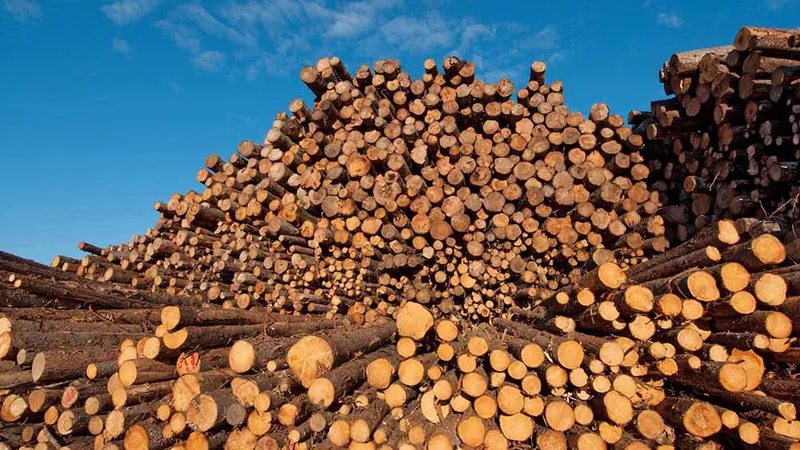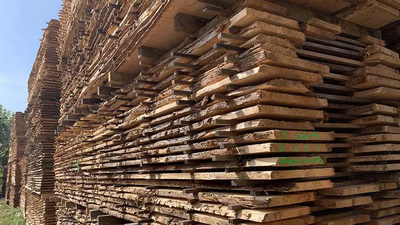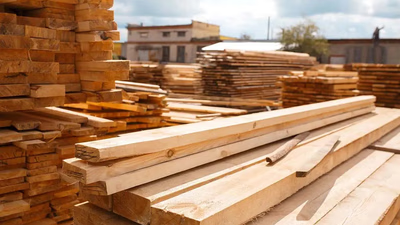
Wood processing enhances quality and marketability in trade.
Exported wood must be of a type that is in demand and use in the global market. Various types of wood are available, including hardwood and softwood, beech, oak, cedar, etc. for various uses. Exported wood must be cut to certain sizes and dimensions and packed. These dimensions should be coordinated with the standards and needs of customers in the target markets. Wood moisture should also be within an acceptable range for export. Proper wood moisture is important to maintain quality and prevent deformation and damage during transportation. In global markets, marketing and advertising strategy is important. Timber exporters must have effective marketing and advertising capabilities to introduce their products to target customers and strengthen competition in the market.
Timber for export must be packed tightly and securely to withstand shocks and physical damage during transportation. Moisture and water resistant packaging can also be effective. The corresponding marks and labels must be placed on the export wood packaging. These marks include information such as wood type, country of origin and destination, dimensions, weight, production date and other necessary information. Certain standards and permits may be required to export wood. such as forest management standards (such as FSC) and other standards related to environmental protection and sustainability.
By processing wood, its appearance can be improved and various designs and motifs can be applied on the wood surface. This can lead to the admiration and attention of more customers and turn wood into a beautiful and unique product. By processing and polishing wood, its physical and mechanical properties can be improved. For example, by using methods such as drying, hydration and stabilization of wood, it is possible to increase the resistance of wood against bending, deformation and moisture changes. Processes such as treating wood with pesticides and anti-rust methods can increase wood's resistance to insects, fungi and rust. This can reduce the need for frequent wood maintenance and increase its useful life.
With some processing processes, certain characteristics can be added to the wood. For example, using waterproofing methods, wood can be made suitable for use in more humid environments. Also, by using anti-fire methods, it is possible to increase the resistance of wood against fire. By processing wood, it can be cut into different shapes and sizes and achieve a greater variety of wood products. This provides customers with more choices and can increase the marketability of the product. Processing and improving the appearance, physical and chemical properties of wood can improve the quality and strength of wooden products and lead to more attractiveness in front of foreign customers. Also, these processes can help develop target markets and increase competitiveness in the wood industry.
Canada is one of the leading countries in the wood industry and has advanced wood processing technologies. This country has advanced equipment for cutting, turning, grinding and welding wood. Germany, having an advanced wood industry and technological companies in this field, produces advanced equipment and new technologies for wood processing. Germany is very advanced in CNC machines, cutting and turning equipment, and advanced wood welding technologies. Focusing on technology and innovation, Japan produces advanced equipment for wood processing. This country is very advanced in cutting, turning, welding and wood restoration technologies.
The United States, having a large wood industry, produces advanced equipment and new technologies for wood processing. This country has advanced cutting, turning, welding and wood restoration technologies. Sweden is active in research and development of advanced technologies for wood processing. This country produces advanced equipment for cutting, turning, welding and wood restoration. Italy is also known as one of the strong competitors in the wood industry and its processing. This country has advanced equipment in the field of cutting, turning, welding and wood restoration.
-

The global wood and timber market has seen substantial growth driven by population increases, construction demands, and rising wood product needs, particularly in developing nations. Major producers include Canada, Russia, the United States, Brazil, and Indonesia, which supply a variety of wood types to international markets. Conversely, China, the U. S. , Japan, and South Korea are the largest consumers due to their industrial requirements. Popular products include wooden furniture and flooring, with chipboard and MDF gaining traction for their affordability and versatility. Thermowood is also emerging as a preferred choice due to its durability against environmental factors. However, the market faces challenges such as fluctuating prices influenced by raw material costs and international competition from countries with extensive resources.
Sustainable practices are increasingly necessary to combat illegal logging and environmental degradation. Countries like Canada and Brazil play pivotal roles in exports to major markets like the U. S. and China. The timber industry must navigate varying regulations that can impact production and trade.
-

Wood trade is crucial for countries to meet their wood needs, with major exporters including Canada, Russia, and the U. S. , while China and India are significant importers. Various wood types like cherry, walnut, pine, oak, teak, mahogany, and cedar are popular for their unique characteristics and applications in furniture and construction. The international timber trade faces challenges from environmental regulations aimed at preventing illegal logging and promoting sustainable practices. The demand for specific woods varies based on their properties; for instance, teak is favored for outdoor use due to its resistance to water and insects. Additionally, the illegal timber trade poses threats to biodiversity and indigenous communities. Countries are increasingly adopting stricter regulations to combat illegal logging while promoting the use of legally sourced wood through organizations like the Forest Stewardship Council (FSC). Despite these efforts, challenges remain in ensuring sustainability within the wood supply chain as construction demands continue to rise.
-

Exporting wood requires adherence to global market demands, focusing on specific types such as hardwood and softwood. Proper sizing, moisture control, and secure packaging are essential to maintain quality during transport. Effective marketing strategies are crucial for timber exporters to reach target customers and enhance competitiveness. Compliance with standards like FSC is necessary for sustainable practices. Wood processing techniques can improve aesthetic appeal and physical properties, increasing marketability. Countries like Canada, Germany, Japan, the USA, Sweden, and Italy lead in advanced wood processing technologies, offering innovative solutions that enhance product quality and durability. By utilizing these technologies, exporters can cater to diverse customer needs while ensuring compliance with environmental standards.
-

The timber market in West Asia, particularly in Saudi Arabia, the UAE, Oman, Qatar, and Iraq, is experiencing significant growth driven by construction and urban development. Each country has unique demands for wood products due to their respective construction needs. To successfully enter this market, businesses must conduct thorough research on local trends, regulations, and competitors. Establishing connections with key industry players through exhibitions and conferences is crucial. Compliance with export laws and environmental standards is essential for building trust with customers. A strong marketing strategy that includes social media and local advertising can enhance brand awareness. Long-term business relationships are vital for securing contracts and expanding opportunities. Additionally, understanding the dual role of Middle Eastern countries as both importers and exporters of timber is important; while some nations rely on imports due to limited resources, others like Turkey and Oman are prominent exporters due to their abundant wood resources. Overall, quality products tailored to local standards can help businesses stand out in a competitive market.




